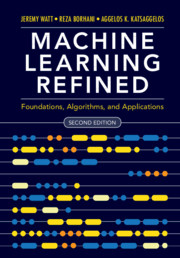Refine search
Actions for selected content:
2327 results in Pattern Recognition and Machine Learning
4 - Model-Based Transfer Learning
- from Part I - Foundations of Transfer Learning
-
- Book:
- Transfer Learning
- Published online:
- 24 January 2020
- Print publication:
- 13 February 2020, pp 45-57
-
- Chapter
- Export citation
6 - Heterogeneous Transfer Learning
- from Part I - Foundations of Transfer Learning
-
- Book:
- Transfer Learning
- Published online:
- 24 January 2020
- Print publication:
- 13 February 2020, pp 68-92
-
- Chapter
- Export citation
10 - Transfer Learning Theory
- from Part I - Foundations of Transfer Learning
-
- Book:
- Transfer Learning
- Published online:
- 24 January 2020
- Print publication:
- 13 February 2020, pp 141-150
-
- Chapter
- Export citation
Index
-
- Book:
- Transfer Learning
- Published online:
- 24 January 2020
- Print publication:
- 13 February 2020, pp 377-380
-
- Chapter
- Export citation
21 - Transfer Learning in Activity Recognition
- from Part II - Applications of Transfer Learning
-
- Book:
- Transfer Learning
- Published online:
- 24 January 2020
- Print publication:
- 13 February 2020, pp 307-323
-
- Chapter
- Export citation
References
-
- Book:
- Transfer Learning
- Published online:
- 24 January 2020
- Print publication:
- 13 February 2020, pp 336-376
-
- Chapter
- Export citation
2 - Instance-Based Transfer Learning
- from Part I - Foundations of Transfer Learning
-
- Book:
- Transfer Learning
- Published online:
- 24 January 2020
- Print publication:
- 13 February 2020, pp 23-33
-
- Chapter
- Export citation

Data Mining and Machine Learning
- Fundamental Concepts and Algorithms
-
- Published online:
- 07 February 2020
- Print publication:
- 30 January 2020
-
- Textbook
- Export citation

Machine Learning Refined
- Foundations, Algorithms, and Applications
-
- Published online:
- 05 February 2020
- Print publication:
- 09 January 2020
-
- Textbook
- Export citation
18 - Probabilistic Classification
- from Part Four - Classification
-
- Book:
- Data Mining and Machine Learning
- Published online:
- 07 February 2020
- Print publication:
- 30 January 2020, pp 469-482
-
- Chapter
- Export citation
4 - Graph Data
- from Part One - Data Analysis Foundations
-
- Book:
- Data Mining and Machine Learning
- Published online:
- 07 February 2020
- Print publication:
- 30 January 2020, pp 92-133
-
- Chapter
- Export citation
22 - Classification Assessment
- from Part Four - Classification
-
- Book:
- Data Mining and Machine Learning
- Published online:
- 07 February 2020
- Print publication:
- 30 January 2020, pp 546-586
-
- Chapter
- Export citation
11 - Graph Pattern Mining
- from Part Two - Frequent Pattern Mining
-
- Book:
- Data Mining and Machine Learning
- Published online:
- 07 February 2020
- Print publication:
- 30 January 2020, pp 282-302
-
- Chapter
- Export citation
8 - Itemset Mining
- from Part Two - Frequent Pattern Mining
-
- Book:
- Data Mining and Machine Learning
- Published online:
- 07 February 2020
- Print publication:
- 30 January 2020, pp 219-243
-
- Chapter
- Export citation
9 - Summarizing Itemsets
- from Part Two - Frequent Pattern Mining
-
- Book:
- Data Mining and Machine Learning
- Published online:
- 07 February 2020
- Print publication:
- 30 January 2020, pp 244-260
-
- Chapter
- Export citation
21 - Support Vector Machines
- from Part Four - Classification
-
- Book:
- Data Mining and Machine Learning
- Published online:
- 07 February 2020
- Print publication:
- 30 January 2020, pp 517-545
-
- Chapter
- Export citation
Part Three - Clustering
-
- Book:
- Data Mining and Machine Learning
- Published online:
- 07 February 2020
- Print publication:
- 30 January 2020, pp 332-333
-
- Chapter
- Export citation
Preface
-
- Book:
- Data Mining and Machine Learning
- Published online:
- 07 February 2020
- Print publication:
- 30 January 2020, pp xi-xii
-
- Chapter
- Export citation
5 - Kernel Methods
- from Part One - Data Analysis Foundations
-
- Book:
- Data Mining and Machine Learning
- Published online:
- 07 February 2020
- Print publication:
- 30 January 2020, pp 134-162
-
- Chapter
- Export citation
25 - Neural Networks
- from Part Five - Regression
-
- Book:
- Data Mining and Machine Learning
- Published online:
- 07 February 2020
- Print publication:
- 30 January 2020, pp 637-671
-
- Chapter
- Export citation
